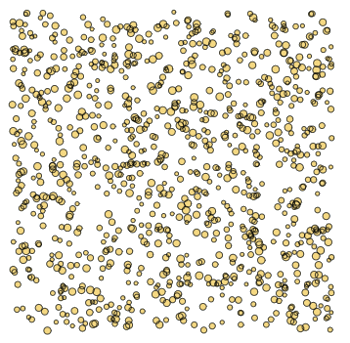
Modeling Cities
July 26, 2013 One of the most interesting things about mathematical modeling is that it can be applied not just to gas molecules in a container, but to most systems. This includes biological systems, such as the predator-prey interaction modeled by the Lotka–Volterra equation; and it also includes the behavior of human populations. Its influence goes beyond the "hard" sciences into the social science disciplines of economics, which is perhaps just semi-soft, sociology, psychology and political science. One current example in the political science area comes from the 2012 US presidential election, in which incumbent president, Barack Obama defeated his Republican opponent, Mitt Romney. It's reported that Obama's re-election team relied heavily on computer modeling as a means to allocate resources.[1-2] In the weeks prior to the November, 2012, election, Obama analysts used polling data to run 66,000 simulated elections every day.[1-2] This is what I often do, myself, in Monte Carlo simulations, and I suspect that the actual number was 65,535, which is the limiting value of an unsigned integer in most computer languages. Such simulations were required because of the quirky nature of the US election process. The winner is determined not by the national popular vote, but by the popular vote in each state, weighted by a factor roughly equivalent to the state's population (its number of Representatives in the House of Representatives), plus a constant (two Senators from each state). The full story can be found by looking at the composition of the US Electoral College. Urban planning is one area in which mathematical modeling has become important, since the world's populations have been steadily leaving the countryside to participate in industries located in larger cities. The figure below, created from data collected by the United Nations, shows that in 2005 more than half of the world's population lived in urban areas, as defined by their respective countries.[3] | The lure of the big city. Percentage of people living worldwide in urban and rural areas between 1950 and 2050 (projected). Unless there are advances in farming technique, and hydroponic factories within cities, we may be headed for a food crisis.[4] (United Nations Data.)[3] |
Two recent papers on arXiv have used mathematics to model the population dynamics of cities.[6-7] One of these looks at the difference between urban mobility and the known trends for long distance travel. Just as in the example that many qualities of city life are exponentially related to population, it was found that that trip length is exponentially distributed.[6]
Item Exponent New patents 1.27 Inventors 1.25 Private R&D employment 1.34 Super-creative employment 1.15 R&D establishments 1.19 Total wages 1.12 Total bank deposits 1.08 New AIDS cases 1.23 Serious crimes 1.16 Length of electrical cables 0.87 Road surface area 0.83
 | Distribution of trip distance for four major cities. Data are in blue, and the model is shown in red. (Fig. 3 of ref. 6, modified for clarity, via arXiv.)[6] |
 | Evolution of a thousand cities after a hundred years.. These virtual cities, placed randomly in a 500 kilometer square, had the same initial population. The size of the circle indicates the population after 100 years. (Fig. 3a of ref. 7, via arXiv.)[7] |
References:
- Michael Scherer, "Inside the Secret World of the Data Crunchers Who Helped Obama Win," Time, November 7, 2012.
- Sam Biddle, "Obama's Campaign Ran Millions of Virtual Elections to Predict the Future," Gizmodo, November 7, 2012.
- Population Division of the Department of Economic and Social Affairs of the United Nations Secretariat, World Population Prospects: The 2010 Revision and World Urbanization Prospects: The 2011 Revision.
- Special Report: The Age of Plenty, IEEE Spectrum, 2013.
- Lués M. A. Bettencourt, José Lobo, Dirk Helbing, Christian Kühnert, and Geoffrey B. West, "Growth, innovation, scaling, and the pace of life in cities," Proc. Natl. Acad. Sci. vol. 104, no. 17 (April 24, 2007), pp. 7301-7306.
- Xiao Liang, Jichang Zhao, Li Dong and Ke Xu, "Unraveling the origin of exponential law in intra-urban human mobility," arXiv Preprint Server, May 28, 2013.
- A. Hernando, R. Hernando and A. Plastino, "Space-time correlations in urban sprawl," arXiv Preprint Server, June 16, 2013.
- Sam Biddle, "Obama's Campaign Ran Millions of Virtual Elections to Predict the Future," Gizmodo, November 7, 2012.